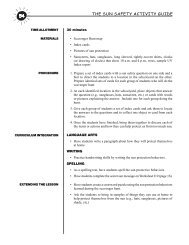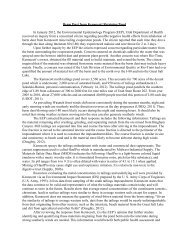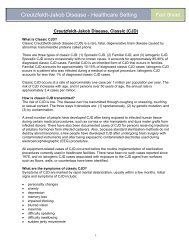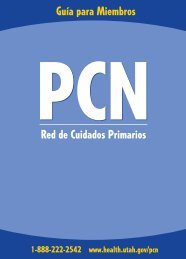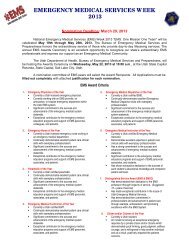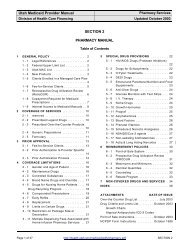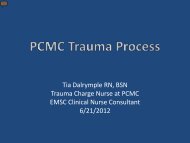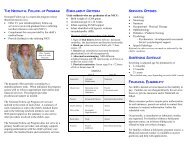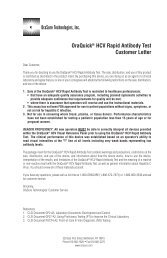Utah Patient Safety Update Vol I No.3 April 2003 - Utah Department ...
Utah Patient Safety Update Vol I No.3 April 2003 - Utah Department ...
Utah Patient Safety Update Vol I No.3 April 2003 - Utah Department ...
Create successful ePaper yourself
Turn your PDF publications into a flip-book with our unique Google optimized e-Paper software.
<strong>Utah</strong> <strong>Department</strong> of Health<br />
<strong>Utah</strong> Hospitals & Health Systems Association<br />
HealthInsight<br />
<strong>Utah</strong> <strong>Patient</strong> <strong>Safety</strong> <strong>Update</strong><br />
Contents<br />
ADEs Among Hospitalized <strong>Patient</strong>s,<br />
January 2001- June 2002 1<br />
About the Data 1<br />
About ICD-9-CM Codes 2<br />
Limitations of Data 2<br />
About Adverse Drug Events 2<br />
ADEs by Class and Group 3<br />
A Common ADE, Rash<br />
A Potential High-Harm ADE,<br />
Adverse Effects of Blood<br />
4<br />
Constituents<br />
Preliminary Findings on ADEs<br />
5<br />
from Inpatient Chart Review 5<br />
ICD-9-CM Codes by ADE Class 6<br />
<strong>Patient</strong> <strong>Safety</strong> Administrative Rule<br />
Percentage of Discharges with<br />
at Least One ADE,<br />
6<br />
January 2002 - June 2002 7<br />
Acknowledgments 8<br />
“[Our] success will be<br />
indicated initially by<br />
seeing an increased<br />
number of events<br />
detected and reported<br />
across the state.”<br />
Scott D. Williams, MD<br />
Deputy Director,<br />
<strong>Utah</strong> <strong>Department</strong> of Health<br />
<strong>April</strong> <strong>2003</strong><br />
health.utah.gov/psi<br />
<strong>Vol</strong> I, No. 3<br />
Adverse Drug Events (ADEs) Among Hospitalized<br />
<strong>Patient</strong>s in <strong>Utah</strong>, January 1, 2001 - June 30, 2002<br />
This update describes the incidence of potential adverse drug events (ADEs) among<br />
hospitalized patients in 41 <strong>Utah</strong> acute care hospitals over three six-month time periods<br />
from January 2001 through June 2002. The update reflects efforts of the <strong>Utah</strong> <strong>Patient</strong><br />
<strong>Safety</strong> Consortium to utilize the Hospital Inpatient Discharge Database to facilitate<br />
patient safety efforts in <strong>Utah</strong>'s hospitals.<br />
This update has three main objectives. First, it shows trends in the reported numbers<br />
and rates of ADEs. Second, the update also shows trends in the rates of rash as an<br />
example of a common ADE and in the rates of adverse effects of agents affecting<br />
blood constituents (such as anticoagulants) as an example of a potential high-harm<br />
ADE. Third, the update reports preliminary findings based on the chart review of<br />
hospital charts of inpatients hospitalized in any of the 41 <strong>Utah</strong> acute care hospitals in<br />
2001.<br />
One of the purposes of the chart review is to validate the ICD-9-CM codes for the 26<br />
classes of ADEs described in this update as well as 40 additional classes of AEs not<br />
reported here. Physician reviews are being conducted on part of the sample of the<br />
charts reviewed by registered nurses trained in medical chart coding.<br />
Like the previous updates, this update's objectives are to report some of the Consortium's<br />
findings to increase understanding of ADEs. Previous studies have indicated that<br />
adverse events may be underreported. The Consortium expects that better recognition,<br />
documentation, and reporting will lead to more accurate estimates of rates of ADEs.<br />
About the Data<br />
The <strong>Utah</strong> Hospital Discharge Database has nine fields for reporting ICD-9-CM<br />
diagnosis codes and one field for reporting the principal E-code. The database contains<br />
patient-level information about all hospitalizations that occur in all of <strong>Utah</strong>'s licensed<br />
hospitals. The <strong>Utah</strong> Health Data Committee, through its staff in the <strong>Utah</strong> <strong>Department</strong><br />
of Health, collects the data under the authority of the <strong>Utah</strong> Health Data Authority Act.<br />
This update compares hospital inpatient discharge data across three half-year periods:<br />
(1) January 1 through June 30, 2001 (discharges = 121,115), (2) July 1 through December<br />
31, 2001 (discharges = 117,936), and (3) January 1 through June 30, 2002 (discharges<br />
= 123,960) (see Table 1, Table 2 and Figure 1). Information about each discharge, or<br />
hospitalization, includes patient characteristics, diagnosis codes, etc. Like the previous<br />
two updates, analysis for this update was restricted to hospitalizations in 41 <strong>Utah</strong> acute<br />
care hospitals, excluding specialty hospitals (such as rehabilitation and psychiatric<br />
hospitals).
About ICD-9-CM Codes<br />
The International Classification of Disease, 9th Revision,<br />
Clinical Modification (ICD-9-CM) has diagnosis and<br />
procedure codes and E-codes. Diagnosis (DX) codes<br />
describe the nature of the patient's diagnosis whereas Ecodes<br />
describe the possible external cause of the injury,<br />
where appropriate. For example, if a drug were thought<br />
to have caused a rash, the diagnosis code would address<br />
the rash (e.g., 782.1), while the E-code would describe<br />
the drug class that was the external cause of the rash<br />
(e.g., E943). While diagnosis codes play a critical role in<br />
determining how much a provider is paid for a service, Ecodes<br />
are not directly related to reimbursement. Currently<br />
there is little financial incentive for E-code reporting.<br />
Therefore, ADEs identified by E-codes probably are<br />
under recorded.<br />
The potential ADEs identified in this analysis may or may<br />
not have occurred prior to contact with a given hospital's<br />
personnel. While principal discharge diagnosis codes (the<br />
codes causing hospitalization) were excluded, secondary<br />
diagnosis and E-codes may represent potential ADEs that<br />
occurred before the patient was hospitalized or potential<br />
ADEs that occurred in the hospital.<br />
Limitations of Using the<br />
Administrative Data and the<br />
ICD-9-CM Classification for<br />
Detecting Adverse Drug Events<br />
• Unable to separate the events that occurred prior to<br />
current hospitalization from those that occurred<br />
during hospitalization<br />
Unable to categorize degree of harm<br />
Unable to capture near misses<br />
Unable to perform reliable inter-institutional<br />
comparisons due to coding variation among facilities<br />
2 <strong>Utah</strong> <strong>Patient</strong> <strong>Safety</strong> <strong>Update</strong> <strong>Vol</strong> I <strong>No.3</strong> <strong>April</strong> <strong>2003</strong><br />
About Adverse Drug Events<br />
Definitions: For the <strong>Utah</strong> patient safety project, an adverse<br />
event (AE) is defined as an undesirable and unintended injury<br />
resulting from a medical intervention (an act of care provided<br />
by the hospital or by the omission of necessary care), rather<br />
than from the patient's underlying disease process. An<br />
adverse drug event (ADE) is an adverse event associated<br />
with a drug.<br />
Classification: ADEs were detected in the <strong>Utah</strong> Hospital<br />
Discharge Database using a classification scheme validated<br />
by the project's expert panel for the ICD-9-CM Classification<br />
of Adverse Events. The scheme designates a set of<br />
approximately 420 ICD-9-CM codes including diagnosis<br />
codes (DX codes) and external-injury codes (E-codes) as<br />
potential ADE codes. These codes are classified into 26 ADE<br />
classes (see Table 1 and Table 3.)<br />
Grouping: The 26 ADE classes fall into three groups:<br />
(1) clinical side effects of drugs (DX codes), (2) poisoning<br />
by drugs (DX codes and E-codes), and adverse effects of<br />
drugs (E-codes). While the clinical side effect classes<br />
describes similar clinical diagnoses, e.g., rash and dermatitis,<br />
the adverse effect and poisoning classes are grouped by type<br />
of drug, such as agents affecting blood constituents (see Table<br />
1, Table 2 and Figure 1).<br />
The <strong>Utah</strong> <strong>Patient</strong> <strong>Safety</strong> Consortium<br />
wishes to thank the hospitals for their<br />
cooperation in the pre-intervention<br />
chart review last year. HealthInsight<br />
will conduct the post-intervention<br />
chart review in late fall, <strong>2003</strong>. We<br />
greatly appreciate the continued<br />
support from the participating<br />
hospitals.
TABLE<br />
1<br />
ICD-9-CM Adverse Drug Event Group and Class<br />
Jan-July<br />
2001<br />
July-Dec<br />
2001<br />
Jan-June<br />
2002<br />
Total Discharges with At Least One Adverse Drug Event 3,813 3,816 4,235<br />
Clinical Side Effects of Drug(s) 885 921 1,029<br />
Drug psychoses 366 439 443<br />
Derm atitis 236 224 261<br />
Maternal causes of perinatal morbidity and mortality, drug reactions 21 15 18<br />
Rash, spontaneous ecchymoses 264 252 310<br />
Poisoning by Drug(s) 678 718 765<br />
Poisoning by antibiotics and other antiinfectives 5 7 8<br />
Poisoning by hormones and synthetic substitutes 16 26 33<br />
Poisoning by primarily systemic agents 34 49 33<br />
Poisoning by agents primarily affecting blood constituents 17 14 20<br />
Poisoning by analgesics, antipyretics, antirheumatics 213 213 248<br />
Poisoning by anticonvulsant and anti-Parkinsonian drugs 43 37 41<br />
Poisoning by sedatives and hypnotics 46 63 68<br />
Poisoning by other CNS depressants, stimulants, anesthetics 40 51 54<br />
Poisoning by psychotropic agents 255 286 306<br />
Poisoning by other agents 117 116 123<br />
Poisoning (undetermined whether accidentally or purposely inflicted) 77 85 79<br />
Adverse Effects by Drug(s) 2,524 2,467 2,743<br />
Adverse effects of antibiotics and other antiinfectives 219 227 279<br />
Adverse effects of hormones and synthetic substitutes 349 294 321<br />
Adverse effects of primarily systemic agents 284 271 295<br />
Adverse effects of agents primarily affecting blood constituents 208 207 230<br />
Adverse effects of analgesics, antipyretics, antirheumatics 488 517 553<br />
Adverse effects of anticonvulsant and anti-Parkinsonian drugs 72 64 81<br />
Adverse effects of sedatives and hypnotics 97 101 137<br />
Adverse effects of other CNS depressants, stimulants, anesthetics 112 95 135<br />
Adverse effects of psychotropic agents 124 150 153<br />
Adverse effects of agents primarily affecting the cardiovascular system 282 254 269<br />
Adverse effects of other drugs, biological, medicinal substances 376 368 379<br />
Total inpatient discharges for the 6-month period 121,115 117,936 123,960<br />
Source: The <strong>Utah</strong>/Missouri <strong>Patient</strong> <strong>Safety</strong> Project, National Expert Panel for ICD-9-CM Classification of Adverse Events, 2002<br />
TABLE<br />
2<br />
Number of Inpatient Discharges with Adverse Drug Event (ADE) by ICD-9-CM Code ADE Group<br />
and ADE Class and Six Month Time Period<br />
<strong>Utah</strong>, 41 Acute Care Hospitals<br />
January 1, 2001 through June 30, 2002<br />
Percentag e of Inpatient Discharg es with Adverse Drug Event (ADE) by ICD-9-CM Code ADE Group<br />
and ADE Class and Six Month Time Period<br />
<strong>Utah</strong>, 41 Acute Care Hospitals<br />
January 1, 2001 through June 30, 2002<br />
ICD-9-CM Adverse Drug Event Group and Class<br />
Jan-July<br />
2001<br />
July-Dec<br />
2001<br />
Jan-June<br />
2002<br />
Total Discharges with At Least One Adverse Drug Event 3.148 3.236 3.416<br />
Clinical Side Effects of Drug(s) 0.731 0.781 0.830<br />
Drug psychoses 0.302 0.372 0.357<br />
Dermatitis 0.195 0.190 0.211<br />
Maternal causes of perinatal morbidity and mortality, drug reactions 0.017 0.013 0.015<br />
Rash, spontaneous ecchymoses 0.218 0.214 0.250<br />
Poisoning by Drug(s) 0.560 0.609 0.617<br />
Poisoning by antibiotics and other antiinfectives 0.004 0.006 0.006<br />
Poisoning by hormones and synthetic substitutes 0.013 0.022 0.027<br />
Poisoning by prim arily systemic ag ents 0.028 0.042 0.027<br />
Poisoning by ag ents primarily affecting blood constituents 0.014 0.012 0.016<br />
Poisoning by analg esics, antipyretics, antirheumatics 0.176 0.181 0.200<br />
Poisoning by anticonvulsant and anti-Parkinsonian drug s 0.036 0.031 0.033<br />
Poisoning by sedatives and hypnotics 0.038 0.053 0.055<br />
Poisoning by other CNS depressants, stimulants, anesthetics 0.033 0.043 0.044<br />
Poisoning by psychotropic ag ents 0.211 0.243 0.247<br />
Poisoning by other ag ents 0.097 0.098 0.099<br />
Poisoning (undetermined whether accidentally or purposely inflicted) 0.064 0.072 0.064<br />
Adverse Effects by Drug(s) 2.084 2.092 2.213<br />
Adverse effects of antibiotics and other antiinfectives 0.181 0.192 0.225<br />
Adverse effects of hormones and synthetic substitutes 0.288 0.249 0.259<br />
Adverse effects of primarily systemic ag ents 0.234 0.230 0.238<br />
Adverse effects of ag ents primarily affecting blood constituents 0.172 0.176 0.186<br />
Adverse effects of analg esics, antipyretics, antirheumatics 0.403 0.438 0.446<br />
Adverse effects of anticonvulsant and anti-Parkinsonian drug s 0.059 0.054 0.065<br />
Adverse effects of sedatives and hypnotics 0.080 0.086 0.111<br />
Adverse effects of other CNS depressants, stimulants, anesthetics 0.092 0.081 0.109<br />
Adverse effects of psychotropic ag ents 0.102 0.127 0.123<br />
Adverse effects of ag ents primarily affecting the cardiovascular system 0.233 0.215 0.217<br />
Adverse effects of other drug s, biolog ical, medicinal substances 0.310 0.312 0.306<br />
Total inpatient discharges for the 6-month period 121,115 117,936 123,960<br />
Source: The <strong>Utah</strong>/Missouri <strong>Patient</strong> <strong>Safety</strong> Project, National Expert Panel for ICD-9-CM Classification of Adverse Events, 2002<br />
<strong>Utah</strong> <strong>Patient</strong> <strong>Safety</strong> <strong>Update</strong> <strong>Vol</strong> I <strong>No.3</strong> <strong>April</strong> <strong>2003</strong> 3
% DISCHARGES<br />
% DISCHAR<br />
2.50<br />
2.00<br />
1.50<br />
1.00<br />
0.50<br />
0.00<br />
0.73%<br />
0.78%<br />
FIGURE 1. PERCENTAGE OF INPATIENT DISCHARGES WITH<br />
AT LEAST ONE ADVERSE DRUG EVENT (ADE)<br />
BY ADE GROUP AND 6 MONTH TIME PERIOD<br />
UTAH, 41 ACUTE CARE HOSPITALS<br />
JANUARY 1, 2001 - JUNE 30, 2002<br />
0.83%<br />
2.08%<br />
2.09%<br />
% CLINICAL SIDE EFFECTS % ADVERSE EFFECTS OF DRUG(S) % POISONING BY DRUG(S)<br />
ICD-9-CM ADE GROUP<br />
JAN-JUNE 2001 JULY-DEC 2001 JAN-JUNE 2002<br />
4 <strong>Utah</strong> <strong>Patient</strong> <strong>Safety</strong> <strong>Update</strong> <strong>Vol</strong> I <strong>No.3</strong> <strong>April</strong> <strong>2003</strong><br />
2.21%<br />
0.56%<br />
0.61% 0.62%<br />
Table 1, Table 2, and Figure 1 show that number and percentage of inpatient discharges with at least one ADE have<br />
increased slightly over the three six month time periods. The confidence intervals (shown as an I symbol on the upper edge<br />
of each bar in Figure 1) indicate that one increase is statistically significant. The percentage of ADEs in the Clinical Side<br />
Effects of Drug group is significantly higher in the third six month time period than the other two time periods. The<br />
increases in the percentage of ADEs in the Poisoning by Drug group and the Adverse Effects of Drug ADE group are not<br />
statistically significant across the three time periods.<br />
% DISCHARGES<br />
% DISCHAR<br />
0.30<br />
0.25<br />
0.20<br />
0.15<br />
0.10<br />
0.05<br />
0.00<br />
FIGURE 2. PERCENTAGE OF INPATIENT DISCHARGES WITH RASH<br />
BY 6 MONTH TIME PERIOD<br />
UTAH, 41 ACUTE CARE HOSPITALS<br />
JANUARY 1, 2001 - JUNE 30, 2002<br />
0.22%<br />
JAN-JUNE 2001 JULY-DEC 2001 JAN-JUNE 2002<br />
6 MONTH TIME PERIOD<br />
Figure 2 shows a slight overall increase in the percentage of inpatient discharges that have at least one ICD-9-CM code<br />
for the ADE Class of Rash. The confidence intervals (shown as an I symbol on the upper edge of each bar in Figure 2)<br />
indicate that the increase from the first and second time periods to the third time period approaches, but does not achieve,<br />
statistical significance.<br />
0.21%<br />
0.25%
% DISCHARGES % DISCHAR<br />
0.30<br />
0.25<br />
0.20<br />
0.15<br />
0.10<br />
0.05<br />
0.00<br />
PERCENTAGE PERCENTAGE OF CHARTS OF CHARTS REVIEWED<br />
R<br />
70%<br />
60%<br />
50%<br />
40%<br />
30%<br />
20%<br />
10%<br />
0%<br />
FIGURE 4. ADVERSE DRUG EVENTS (ADEs) IDENTIFIED BY ICD-9-CM CODES<br />
PRELIMINARY FINDINGS FROM INPATIENT CHART REVIEW<br />
BY ADE GROUP AND REVIEW GROUP<br />
UTAH, 41 ACUTE CARE HOSPITALS<br />
JANUARY 1, 2001 - DECEMBER 31, 2001<br />
21%<br />
FIGURE 3. PERCENTAGE OF INPATIENT DISCHARGES WITH<br />
ADVERSE EFFECTS OF BLOOD CONSTITUENTS<br />
BY 6 MONTH TIME PERIOD<br />
UTAH, 41 ACUTE CARE HOSPITALS<br />
JANUARY 1, 2001 - JUNE 30, 2002<br />
0.17%<br />
JAN-JUNE 2001 JULY-DEC 2001 JAN-JUNE 2002<br />
Figure 3 shows slight increases in the percentage of inpatient discharges that have at least one ICD-9-CM code for the<br />
ADE Class of Adverse Effect of Agents Affecting Blood Constituents across the three six month time periods. The<br />
confidence intervals (shown as an I symbol on the upper edge of each bar in Figure 3) indicate that these increases are not<br />
statistically significant.<br />
34%<br />
44%<br />
6 MONTH TIME PERIOD<br />
49%<br />
32%<br />
CLINICAL SIDE EFFECTS DX CODES ADVERSE EFFECTS OF DRUGS E-CODES POISONING BY DRUGS DX AND E-CODES<br />
19%<br />
ICD-9-CM ADE GROUP<br />
ARRIVED WITH ADE INPATIENT ADE NOT ADE*<br />
Note: The analysis includes reviewed charts with at least one ICD-9-CM ADE code as a secondary diagnosis code and excludes the<br />
reviewed charts that have the same ICD-9-CM ADE code group as the primary diagnosis. NOT ADE* means that the chart was flagged<br />
as likely to include an ADE but the reviewer determined that an ADE was not present.<br />
Figure 4 shows higher portions of ADEs that occurred in the hospital (inpatient ADEs) in two of the three ADE groups,<br />
Clinical Side Effects of Drug (34%) and Adverse Effects of Drug (32%). In contrast, a lower portion of the Poisoning by<br />
Drug group (17%) occurred in the hospital (inpatient ADEs). Higher portions of ADEs in the Poisoning by Drug group<br />
were present when the patient was admitted to the hospital (arrived with ADEs). These findings suggest that ICD-9-CM<br />
codes in the Clinical Side Effects of Drug and Adverse Effects of Drug groups are stronger predictors of inpatient ADEs<br />
than the ICD-9-CM codes in the Poisoning by Drug group.<br />
0.18%<br />
<strong>Utah</strong> <strong>Patient</strong> <strong>Safety</strong> <strong>Update</strong> <strong>Vol</strong> I <strong>No.3</strong> <strong>April</strong> <strong>2003</strong> 5<br />
60%<br />
17%<br />
0.19%<br />
23%
TABLE<br />
3<br />
The ICD-9-CM Codes of Adverse Drug Events (ADE) by ADE Class<br />
<strong>Utah</strong>, 41 Acute Care Hospitals, 2002 Version<br />
Class # Adverse Event Class ICD-9-CM Codes Included<br />
1 Drug psychoses 292<br />
2 Derm atitis<br />
3 Maternal causes of perinatal morbidity and mortality, Drug reactions and<br />
692.3,692.9,693.0,693.8,693.9<br />
intoxications specific to newborn 760.72,760.74,763.5,779.4<br />
4 Rash, spontaneous ecchymoses 782.1,782.7<br />
5 Poisoning by antibiotics and other antiinfectives 960-961, E856-857<br />
6 Poisoning by hormones and synthetic substitutes 962, E858.0<br />
7 Poisoning by primarily systemic agents 963, E858.1<br />
8 Poisoning by agents prim arily affecting blood constituents 964, E858.2<br />
9 Poisoning by analgesics, antipyretics, antirheumatics 965, E850<br />
10 Poisoning by anticonvulsant and anti-Parkinsonian drugs 966, E855.0<br />
11 Poisoning by sedatives and hypnotics<br />
12 Poisoning by other CNS depressants, stimulants, anesthetics, nervous<br />
967, E851-852<br />
system agents 968, E855.1-855.9<br />
13 Poisoning by psychotropic agents 969, E853, E854<br />
14 Poisoning by other agents 909.0, 970-979, E858.3-858.9,<br />
E929.2<br />
15 Adverse effects of antibiotics and other antiinfectives E930-E931<br />
16 Adverse effects of hormones and synthetic substitutes E932<br />
17 Adverse effects of primarily systemic agents E933<br />
18 Adverse effects of agents primarily affecting blood constituents E934<br />
19 Adverse effects of analgesics, antipyretics, antirheumatics E935<br />
20 Adverse effects of anticonvulsant and anti-Parkinsonian drugs E936<br />
21 Adverse effects of sedatives and hypnotics<br />
22 Adverse effects of other CNS depressants, stimulants, anesthetics, nervous<br />
E937<br />
system agents E938, E940-941<br />
23 Adverse effects of psychotropic agents E939<br />
24 Adverse effects of agents primarily affecting the cardiovascular system<br />
25 Adverse effects of other drugs, biological, medicinal substances in therapeutic<br />
E942<br />
use E943-E949.909.5<br />
26 Poisoning (undetermined whether accidentally or purposely inflicted) E980.0-E980.5,E980.9<br />
Source: The <strong>Utah</strong>/Missouri <strong>Patient</strong> <strong>Safety</strong> Project, National Expert Panel for ICD-9-CM Classification of Adverse Events, 2002<br />
Table 3 shows the classification of 420 ICD-9-CM DX codes and E-codes in 26 classes of ADEs as described in this<br />
report's section, "About Adverse Events." A detailed list of the codes for these 26 ADE classes, as well as the other 40<br />
classes of adverse events, is available on the website health.utah.gov/psi.<br />
Health Care Facility <strong>Patient</strong> <strong>Safety</strong> Program and Administrative Rule<br />
The <strong>Utah</strong> Hospitals and Health Systems Association (UHA), jointly with the <strong>Utah</strong> Medical Association (UMA) and <strong>Utah</strong><br />
<strong>Department</strong> of Health (UDOH), established a patient safety task force in 2000. This task force initiated the discussion of and<br />
endorsed the administrative rule on patient safety that went into effect on October 1, 2001.<br />
The Health Care Facility <strong>Patient</strong> <strong>Safety</strong> Program Rule requires that:<br />
1) Each facility shall implement processes to effectively identify and report to the <strong>Department</strong> the incidence of all: a) adverse<br />
drug events.<br />
2) Reporting to the <strong>Department</strong> may occur through established, statewide, electronic health care facility reporting systems<br />
managed by the <strong>Department</strong>.<br />
3) The report shall include codes applicable to the event from the current International Classification of Diseases Clinical<br />
Modification (ICD-CM) diagnosis coding, including codes for external cause of injury (E-codes) and codes for place of<br />
occurrence.<br />
A variety of methods are available for detecting and tracking adverse drug events. They are:<br />
Traditional incident reporting<br />
Retrospective chart review<br />
Automated detection based on clinical response<br />
Daily pharmacist chart review<br />
Hospital discharge data reporting<br />
Hospitals can select any of the methods and report quarterly the aggregated number of ADEs to the <strong>Utah</strong> <strong>Department</strong> of Health.<br />
6 <strong>Utah</strong> <strong>Patient</strong> <strong>Safety</strong> <strong>Update</strong> <strong>Vol</strong> I <strong>No.3</strong> <strong>April</strong> <strong>2003</strong>
ADE CLASS<br />
FIGURE 5. PERCENTAGE OF INPATIENT DISCHARGES WITH AT LEAST ONE ADVERSE DRUG EVENT (ADE)<br />
BY ADE CLASS, UTAH, 41 ACUTE CARE HOSPITALS, JANUARY 1, 2002 - JUNE 30, 2002<br />
Adverse effects of analgesics, antipyretics, antirheumatics<br />
Drug psychoses<br />
Adverse effects of other drugs, biological, medicinal substances<br />
Adverse effects of hormones and synthetic substitutes<br />
Rash, spontaneous ecchymoses<br />
Adverse effects of psychotropic agents<br />
Adverse effects of primarily systemic agents<br />
Adverse effects of antibiotics and other antiinfectives<br />
Adverse effects of agents primarily affecting the cardiovascular system<br />
Dermatitis<br />
Poisoning by analgesics, antipyretics, antirheumatics<br />
Adverse effects of agents primarily affecting blood constituents<br />
Poisoning by psychotropic agents<br />
Adverse effects of sedatives and hypnotics<br />
Adverse effects of other CNS depressants, stimulants, anesthetics<br />
Poisoning by other agents<br />
Adverse effects of anticonvulsant and anti-Parkinsonian drug s<br />
Poisoning (undetermined whether accidentally or purposely inflicted)<br />
Poisoning by sedatives and hypnotics<br />
Poisoning by other CNS depressants, stimulants, anesthetics<br />
Poisoning by anticonvulsant and anti-Parkinsonian drugs<br />
Poisoning by primarily systemic agents<br />
Poisoning by hormones and synthetic substitutes<br />
Poisoning by agents primarily affecting blood constituents<br />
Maternal causes of perinatal morbidity and mortality, drug reactions<br />
Poisoning by antibiotics and other antiinfectives<br />
0.099<br />
0.065<br />
0.064<br />
0.055<br />
0.044<br />
0.033<br />
0.027<br />
0.027<br />
0.016<br />
0.015<br />
0.006<br />
Figure 5 shows the rank order of the 26 ADE classes by percentage of inpatient discharges with at least one ADE. See<br />
Table 1 and Table 2 for trend data for these ADE classes. The values and rank ordering shown here for the first two<br />
quarters of 2002 are similar, though not identical, to those for all four quarters of 2000 shown in <strong>Patient</strong> <strong>Safety</strong> <strong>Update</strong> <strong>Vol</strong>.<br />
I, No. 1. For both years, percentage for adverse effects of a particular kind of drug (e.g. adverse effects of analgesics,<br />
antipyretics, antirheumatics) and clinical side effects (e.g., drug psychoses) tend to be higher than for poisoning by a<br />
particular kind of drug (e.g., poisoning by analgesics, antipyretics, antirheumatics).<br />
0.111<br />
0.109<br />
0.123<br />
0.186<br />
0.211<br />
0.200<br />
0.225<br />
0.217<br />
0.250<br />
0.247<br />
0.238<br />
0.000 0.050 0.100 0.150 0.200 0.250 0.300 0.350 0.400 0.450 0.500<br />
0.259<br />
% DISCHARGES<br />
0.306<br />
0.357<br />
0.446<br />
<strong>Utah</strong> <strong>Patient</strong> <strong>Safety</strong> <strong>Update</strong> <strong>Vol</strong> I <strong>No.3</strong> <strong>April</strong> <strong>2003</strong> 7
Office of Health Care Statistics<br />
Center for Health Data<br />
<strong>Utah</strong> <strong>Department</strong> of Health<br />
PO Box 144004<br />
Salt Lake City, UT 84114-4004<br />
Phone: 801-538-7048<br />
Fax: 801-538-9916<br />
Email: HealthCareStat@utah.gov<br />
<strong>Utah</strong> <strong>Patient</strong> <strong>Safety</strong> <strong>Update</strong><br />
<strong>April</strong> <strong>2003</strong><br />
<strong>Vol</strong> I, No. 3<br />
Office of Health Care Statistics<br />
<strong>Utah</strong> <strong>Department</strong> of Health<br />
P O Box 144004<br />
Salt Lake City, <strong>Utah</strong> 84114-4004<br />
RETURN SERVICE REQUESTED<br />
Acknowledgments<br />
This project is supported by grant number U18 HS11885 from the Agency for<br />
Healthcare Research and Quality and under the guidance of the <strong>Utah</strong>/Missouri<br />
<strong>Patient</strong> <strong>Safety</strong> Consortium. The Consortium includes the following members:<br />
<strong>Utah</strong> <strong>Department</strong> of Health<br />
HealthInsight<br />
UHA, <strong>Utah</strong> Hospitals and Health Systems Association<br />
University of <strong>Utah</strong>, <strong>Department</strong> of Medical Informatics<br />
LDS Hospital, Intermountain Health Care<br />
Missouri <strong>Department</strong> of Health and Senior Services<br />
Missouri <strong>Patient</strong> Care Review Foundation<br />
University of Missouri – Columbia, School of Medicine<br />
This report was developed by Dr. Carol Masheter, formatted by Heidi Bergvall<br />
and reviewed by Dr. Paul Hougland and Dr. Wu Xu.<br />
For more information about this project, contact Paul Hougland at<br />
(801) 538-6353 or HealthCareStat@utah.gov.<br />
For more copies of this update, please go to http://health.utah.gov/psi/pubs/<br />
psup_v1n3.pdf.



